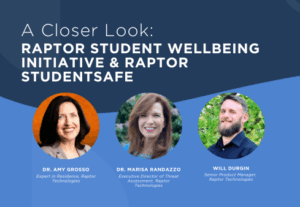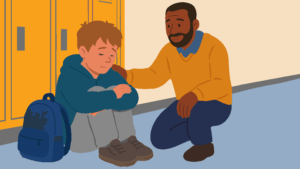Listen to this blog
4 minutes
As conversations about school safety continue to develop, parents are increasingly focused on schools’ security offerings in addition to their mission and academic rigor. Tools that enable you to be informed about who you allow on campus, streamline emergency responses, and better support student wellbeing will strengthen the hedge of protection your school wraps around its students and staff —and is the best way to love on your community’s most vulnerable members: the children.
The importance of safety, even—and especially—in small communities
There are many benefits to the close-knit communities that flourish at private schools on account of staff and families sharing a common mission. One such benefit is that school staff often know most parents, so recognizing an unauthorized visitor is more easily accomplished. As a result, if a visitor sign-in procedure exists, it’s often rudimentary and done on paper with staff recognizing authorized visitors on sight.
But using this outdated method, even in such a community, opens the door for safety and security concerns that leave the school vulnerable. Consider the following scenarios:
- A school contractor worked at a school for three weeks before they implemented Raptor Visitor Management—and he was flagged as a sex offender. He had not notified the school.
- A field trip volunteer—who had transported students on trips—underwent the newly-implemented volunteer application and screening process through Volunteer Management. They had a DWI on their record.
- A parent keeps the details of a divorce discreet, sharing that knowledge with just the administrative staff. Because Visitor Management supports custom data, the school can uphold custody agreements, so the student remains safe.
- A fire alarm sounds and the school evacuates—but loose visitor sign-in procedures complicate accounting for the safety of each individual on their campus.
Further, while some private schools are blessed with dedicated campuses and buildings, many private and church schools are renting or borrowing facilities from houses of worship, retail parks, or other commercial structures. These buildings come with unique challenges.
- Most of the campuses have little or no perimeter fencing, and parking lots are usually open. It is difficult to keep trespassers off the grounds during and after school hours. Vandalism, theft, and unwanted visitors are often the result.
- Having multiple points of entrance/exit—especially those with glass doors—creates a risk to students and staff.
- Since many of these buildings may host other tenants or support multiple programs during the week, it is not always known who is on campus and what risk they may pose.
1. Know your campus security’s strengths and weaknesses
Work with your facility’s department, landlords, or houses of worship to control access to the school facility and hire an independent security auditor to assess the overall security of the campus. This would include looking at the following:
- Physical infrastructure as well as plans, drills and everyday safety practices.
- Campus access—controlling access through 6-foot (or higher) perimeter fencing with gates on parking lot entrances/exits are a good start—but if that is not possible, hiring a security company to monitor and walk the campus can be a substitute measure.
- High resolution exterior cameras on entrances and parking lots can be expensive but are also a good choice to help monitor access.
This audit should establish the baseline for where the school is in its safety and security journey.
2. Know who is on campus and control traffic flow

Creating controlled entrances and exits for campus visitors by physically locking or using access control systems is imperative.
- Require uniforms and identification cards for both students and staff. This will enable staff to easily identify who does not belong on campus and challenge them.
- On entrances that feature glass doors and windows, installation of bullet resistant film is highly recommended.
- Lock interior doors as well as exterior doors and have people funnel through a visitor management system that not only provides badges, but also screens visitors against the sex offender databases.
Raptor Visitor Management can be a game changer. Screening visitors and contractors against a sex offender registry, and parents against the school’s custody and banned individual database reduces risk for the school and to its students and staff. Printing badges with the time of entry and where the visitor is supposed to be on campus makes it easier for staff to challenge a visitor who is where they do not belong.
3. Prepare for emergencies
It is best practice for private schools to conduct safety drills as often as public schools so that students and staff are familiar with how to respond if an emergency occurs. To develop a culture of safety within your private school, consider the following:
- Mandate policies and practices across the school, using state regulations and emergency response plan (ERP) templates as a starting point. A comprehensive ERP should cover everything from the smallest emergency to worst case scenario and should be revisited at least twice a school year.
- Use your high level of parental involvement to form safety committees and teams to help develop the ERP. Board members, local law enforcement, administrators, teachers, and even students can also help fill this committee.
- Establish a regular cadence of drills, administrator/teacher trainings, safety audits, mandated practices, and tabletop exercises. Drills are imperative and should include local agencies so that teachers, students, emergency responders, and even parents are familiar with the emergency practices of the school.
- Review your plan with local law enforcement and first responders so that they are familiar with the school and its practices and will have points of contact should an emergency arise.
Raptor Emergency Management enables you to effectively manage drills, instantly notify first responders, accurately account for individuals and safely reunify families. At the center of the Raptor Emergency Management Suite is Raptor Alert. Designed to work under duress, Raptor Alert is a silent panic alert system that works on the devices your schools use every day. Raptor Alert expedites and streamlines emergency response by allowing users to initiate an alert directly through 911 and provide critical information to first responders, law enforcement, and campus personnel.
4. Caring for the whole child
One of the ways you can stay on mission is by caring for the mental health and welfare of your children. One advantage to smaller schools is their awareness and lower teacher-to-student ratios, which means it may be easier to identify when a student is struggling or in an emotional crisis. But because private schools often lack the mental health resources that public schools have, some struggling students may go unnoticed—and therefore untracked and unaddressed.
Documenting and tracking concerns about a student’s wellness is critical to improving that student’s wellbeing, to protecting your students and staff, and—because private schools lack the liability protections of public institutions, which means a single incident could easily shutdown a school for good—to protecting your school’s positive impact on your community.
Support the individual, holistic safety of your students with Raptor’s patented StudentSafe technology. Bringing together the systems that help schools recognize, document, support, and manage the wellbeing of individual students, the StudentSafe platform includes the safeguarding and behavioral threat assessment (BTA) methodologies that are proven to help schools recognize a student in need of early intervention and support for their wellbeing.
Raptor can help all schools enhance safety
Private schools face unique challenges, but Raptor is ready to help. Serving over 2000 Private and Catholic schools of all shapes and sizes nationwide, the Raptor School Safety Suite is a valuable asset that all schools can use to enhance safety on their campuses. Raptor helps schools keep unwanted entrants out, support student wellbeing, and confidently respond to any emergency—all in one, user-friendly integrated suite.
Schedule a demo to learn more about how Raptor can help your school.
Related Resources
Guide to K-12 Student Wellbeing
Strategies to Recognize, Document, and Support Students in Distress
Listen to this blog
4 minutes







